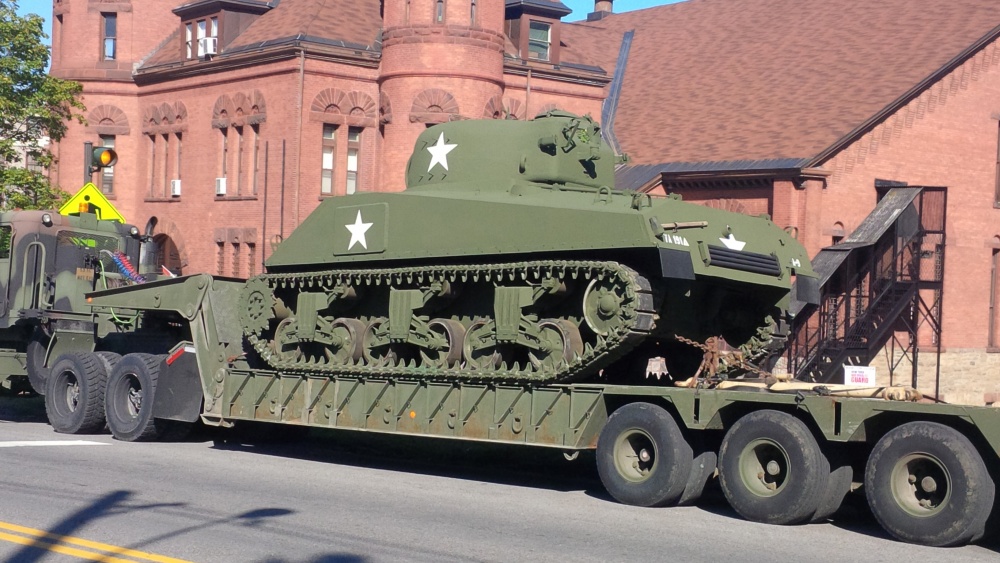

There is supposedly a famous quote from Dwight Eisenhower about his “Four Tools for Victory” in World War II, but that quote has been hard to pin down exactly. Several variations exist that include six of the seven tools listed below. The M1 Garand also made the list because, as Gen. George Patton said, “the M1 rifle is the greatest battle implement ever devised.”
1. The Jeep

While the origins of the name “Jeep” may be up for debate, the rugged-dependable-go-anywhere nature of the Jeep is not.
The Jeep – quite literally – became the workhorse of the American military as it replaced horses in everything from cavalry units to supply trains. Field-expedient improvements made the Jeep capable of just about any mission the GI’s could dream up for it.
Jeeps were so ubiquitous in the European theatre that the Germans thought each American was issued their own. Famed sports car designer Enzo Ferrari described the Jeep as “America’s only real sports car.”
Without the Jeep’s rugged dependability and offensive capabilities, winning the war would have been much more difficult for the Allies.
2. The C-47

While American bombers surely wrought havoc on the Axis powers, it is the C-47, the beloved “Gooney Bird,” that is always cited as a Tool for Victory.
This probably has to do with the fact that the C-47’s flew everywhere and did everything.
C-47’s kept the Allies supplied by flying “the Hump” over the Himalayas, they evacuated wounded soldiers from near the front lines, and they flew over occupied territory to drop Allied paratroopers behind enemy lines.
3. The Bazooka

The Bazooka, or official Rocket Launcher, M1, was a man-portable, recoilless, anti-tank weapon.
Not only did the Bazooka pack more punch than any other man-portable weapon, it was also versatile. With the development of different warheads, the Bazooka could be an anti-tank weapon, a bunker buster, or an anti-personnel weapon. One inspired pilot even attached them to his scout plane to fight German tanks.
The weapon’s versatility and combat prowess caught the eye of Gen. Eisenhower and it is generally listed as one of his four Tools for Victory.
4. The Higgins Boat

The Landing Craft, Vehicle, Personnel (LCVP), or simply the Higgins Boat, is easily one of the most important tools on this list.
“Higgins is the man who won the war for us,” Eisenhower said. If it hadn’t been for his boats, “the whole strategy of the war would have been different.” The boat’s shallow draft and full-size ramp allowed it to carry 36 fully loaded infantrymen, a Jeep, and a squad, or up to 8,000 pounds of cargo directly onto the beaches under assault.
It could then quickly turn around and repeat the procedure as necessary. The LCVP was at every single American amphibious assault throughout the war.
5. The Sherman Tank

The M4 Sherman tank was far from the best tank fielded in World War II. In fact, it was often outmatched by the much stronger German tanks. But the Sherman had a few things that made it such a formidable weapon.
The simplicity of production of the Sherman, and the lack of destruction of American factories, combined with a strong repair and refit program, meant there were always plenty of Shermans. This translated on the battlefield into numerical superiority, which allowed the Allies to simply overwhelm German armored units that had little means of replenishment.
Continuous improvements throughout its service life also continued to make the Sherman a formidable foe for enemy tanks.
6. The M1 Garand

It is well known how Patton felt about the M1 Garand, but what else was it about the rifle that made it a Tool for Victory?
For one, while most of the world’s armies were still using bolt-action rifles, the M1 could deliver eight rounds of .30-06 as fast as a man could pull the trigger. This gave the American rifleman a serious advantage over his foes.
The weapon was also extremely accurate, rugged, and dependable. The M1 was so effective, in fact, that it significantly changed infantry tactics. The M1 rifle saw heavy combat on all fronts and was a vital tool for the American infantry in winning the war.
7. The Atomic Bomb

The incredible destructive power of the atomic bombs that were dropped on Hiroshima and Nagasaki was undeniable.
With just two missions over Japan, the Allies were able to secure the unconditional surrender of the Japanese. This ended World War II.
But there was more to it than just victory. The atomic bombs ending the war meant countless American lives saved from not having to invade Japan. The United States anticipated some 500,000 casualties from the invasion that never came and created Purple Heart medals accordingly.
Thanks to the atomic bombs, those medals have supplied U.S. forces ever since.
